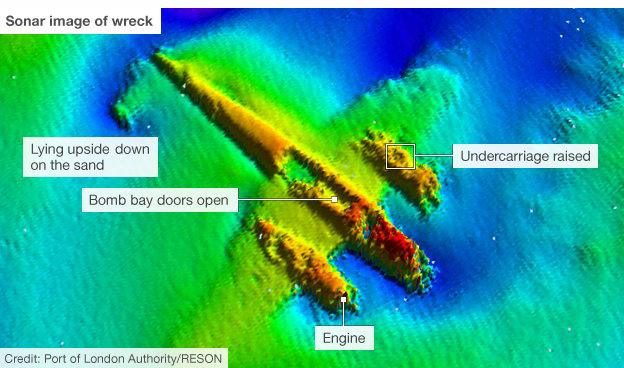German bomber salvage attempt delayed
- Published
Ian Thirsk, RAF Museum: "We've come too far to give up at this stage"
An attempt to raise a unique World War II German aircraft from the bottom of the English Channel has been abandoned for the night because of high winds.
Divers had hoped to begin lifting the only surviving Dornier 17 at 21:00 BST but have decided to delay the bid.
A spar, attached to lifting cables and struts in the wings, is to be inserted through the bomber's fuselage, which lies in 50ft of water off Kent.
The plan, devised by the RAF Museum, has been repeatedly hit by bad weather.
The salvage attempt at Goodwin Sands was scheduled to take place at midday on Monday but the weather - bright sunshine and calm waters during Sunday afternoon - is expected to deteriorate over the next 24 hours and it was brought forward.
But organisers made a decision to call off the attempt because of the weather and the salvage barge is now returning to Ramsgate.
Since the salvage barge - GPS Apollo - dropped anchor over the wreck on 3 May, a total of 16 days of diving have been lost and the barge has had to take refuge in Ramsgate harbour four times.
Shot down
The original plan to build an aluminium frame or cradle around the fragile wreck was abandoned after it became clear it would take too long and send the £600,000 project way over budget.
Instead, divers are to insert a spar along the inside of the fuselage and attach lifting cables to that and to a pair of struts, part of the original airframe, running the length of both wings.
This method is riskier because it depends to a much greater degree on the structural integrity of an aircraft which has spent more than 70 years buried in sand.
The Dornier 17 was a mainstay of the German bomber fleets during the Battle of Britain in 1940.
The plane on the Goodwin Sands is believed to be aircraft call-sign 5K-AR, shot down on 26 August that year at the height of the battle by RAF Boulton-Paul Defiant fighters.
There were four crew members on board; two - including the pilot - survived to become prisoners of war. The bodies of the other two washed ashore and were buried elsewhere.
If the wreck is successfully raised, the RAF Museum plans to undertake work to preserve it before exhibiting at the museum's main base at Hendon in north London.

The Dornier 17 was a mainstay of the German bomber fleets during the Battle of Britain
- Published31 May 2013
- Published4 May 2013
- Published8 May 2013
- Published4 May 2013
- Published30 May 2013